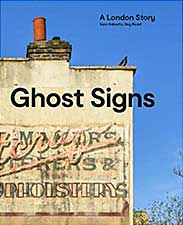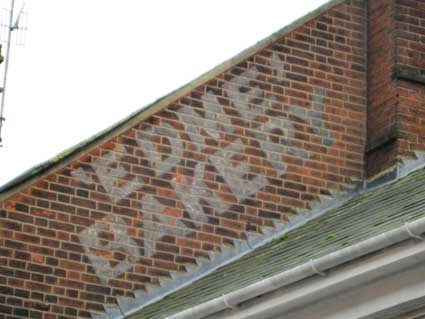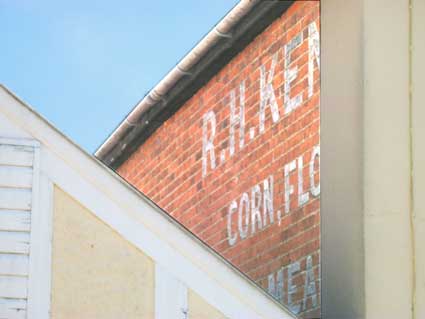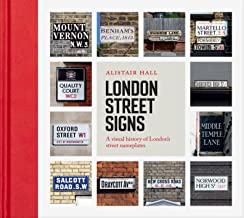Background information on ghost signs
‘Ghost signs are fascinating pieces of
urban archaeology.’
 We are indebted to the 2021
book Ghost
signs: a London story by Sam Roberts and Roy Reed (see Reading
list) for opening the door on the mysteries of advertising signs on
walls. The term 'ghost sign' has grown in usage over about ten years or
so to denote those traces of trade lettering painted onto walls mainly
in the twentieth century. Some people will walk past these traces of
history hardly noticing them.
Others may wonder ‘why and how did they do that?’.
We are indebted to the 2021
book Ghost
signs: a London story by Sam Roberts and Roy Reed (see Reading
list) for opening the door on the mysteries of advertising signs on
walls. The term 'ghost sign' has grown in usage over about ten years or
so to denote those traces of trade lettering painted onto walls mainly
in the twentieth century. Some people will walk past these traces of
history hardly noticing them.
Others may wonder ‘why and how did they do that?’.
Characteristics of signs
Palimpsest:
this is a word taken from the study of ancient manuscripts;
a manuscript or piece of writing material on which later writing has
been superimposed on effaced earlier writing. This term was introduced
to us by Bob Allen, Vice President of The Ipswich Society. Wall signs
are usually paint on brick or render – and open to the elements. Often
proprietors had the fading signs repainted over time. Weathering can
gradually reveal layers underneath; this is most clearly demonstrated
in Ipswich on the Elliott Street Bakery
sign. Things become more
confusing where an earlier trade sign is covered by later different
trades.
Eyecatcher walls: our
expression for areas of buildings, often on
busier roads, which are clearly visible to passers-by (pedestrians,
drivers, those on public transport including trains) to promote a
business or product. ‘Leading edge’ walls such as that seen on the H.W.
Turner sign in St Helens Street can be utilised, in this case for
vertical lettering. There are several examples in Ipswich where a
suitable wall is used to catch the eye of travellers in a particular
direction, but are obscured by later buildings next door: ‘Nestlé’s
Milk’ in Bramford Road and ‘Family Grocer’
in Derby Road. Sometimes
signs are sited in apparently out-of-the-way places; see ‘Symonds for
Kodaks’ in Upper Brook Street, ‘Edme
Bakery’ in Dogs Head Street, ‘R.H.
Kent’ in Dove Street.
Finance: who paid for the
sign; what did it advertise? The commonest
signs are on the walls or frontages of shops and business premises.
These would have been commissioned by the proprietor from a local
sign-writer – it makes good business sense to promote your business and
to mark its location. “British Flag
Stores” (sign now covered) on
Wellesley Road, ‘Claydon Hall Dairy’
on Bramford Lane, ‘Scarborow’ in
Dial Lane and ‘Confectionery Works’
(now demolished) in Woodbridge Road
are all Ipswich examples.

Privileges: However, sometimes
national brands sought out suitable
sites across the country for advertising; this usually benefitted an
existing trader by mentioning them in smaller lettering. The ‘Nestlé’s
Milk’ sign in large letters in Bramford Road also mentions ‘A. Rouse
Grocer and Provision Merchant’ at the bottom. The Hovis company
was an enthusiastic promoter of their brand from 1890 when the name was
coined. The familiar gold capitals in relief on a green background can
still be seen at 113 Bramford Road. Newsagents and tobacconists are
famously prone to promote one brand on their shop-fronts with their own
names smaller – see the intrusive ‘The Sun’ and ‘News of the World’
signs on 132-4 Fore Street; ‘Emeny’
Newsagent at the top of Grimwade
Street used to boast several such privileges. Privileges are mutually
beneficial to the proprietor and the national brand.
Another type of privilege is found when a national brand leases a
prominent wall from the owner (often a private resident) to advertise
their products. We’re thought that the ‘Egertons’
painted sign(s) on the
rear wall of Yates Wine Lodge, Tower Street might have counted as a
privilege. The
main Egertons works and showroom was 100 yards along Crown Street, but
it turns out that the
Wine Lodge building was once a showroom for the car company? This sign
also benefits from a BP petrol privilege. Two other examples may well
have been privileges unrelated to the premises are ‘Kays Ways Pays’
(now painted over) in Orwell Place and the nearby ‘Drink Topal Tea’ in
Eagle Street.
A number of companies were engaged in finding sites, contracting
privileges and applying wall advertisements, some using their own
in-house designers and signwriters. This became a big, lucrative
business. These signs were the forerunners of billboard advertisements
and some of the companies transitioned to the latter approach. Perhaps
ironically, original ghost signs (because of their prominent,
eyecatcher siting) were often covered by advertising billboards which
served to protect the wall signs; these eventually became visible when
billboards came to be seen as eyesores and were taken down.
Design and execution
For a smaller space a signwriter might draw up a design
on paper
(sometimes to get the approval of the proprietor), then draw to sign
freehand onto the wall. Oil-based paint would then be applied with a
stiff hogs-hair brush to insist the paint into the uneven and porous
wall surface. The artist’s mahlstick (or maulstick) are much usedby
signwriters to steady the hand and work over existing work without
smudging it. All this often working on a high ladder, or scaffolding in
indifferent weather. Brick courses were often used to ensure that
lettering was level, although all sorts of angled, cursive letterforms
were also employed, as seen on Elliott Street Bakery.

But how would a large-scale advertisement such as those seen in
Hamilton Road, Felixstowe: ‘E.F. Andrews,
Decorator’ and Bramford Road,
Ipswich (‘W.B. Kerridge, Tailor’) be
created, particularly running
trade names on a broad curve? Pouncing is the answer:
‘Pouncing is a method of transferring a preparatory drawing for a
painting from paper to another surface, such as canvas or plaster. The
artist would prick holes around the outlines of the drawing, place it
over the second surface, and then dust powder such as chalk or charcoal
through the holes. Pouncing can also refer to the dotted outline left
on the second surface.’ [Definition from The National Gallery]
So, a full-size paper rough would be created, perhaps in sections, and
attached to the wall. Previously the drawing would have been pricked,
probably using a pouncing wheel rather than a single stiletto. Then a
pouncing bag would be struck or rubbed over the pricked lines to leave
a trace on the wall’s surface. This would provide the outlines of the
sign for paint to be applied. One can only admire the ambition, skill,
craftsmanship and (possibly) foolhardiness of the signwriters who might
well be called back some years later to paint over and then repaint the
sign, or apply another.
Preservation and loss
Painted wall signs have often survived billboards,
electrical neon
signs, die-cut plastic, digital screens and other essentially temporary
means of proclaiming a trader or product. The old painted signs, once
considered to be not worth removing or covering over are more commonly
appreciated and enjoyed as small signifiers of our social and economic
history. We hope that sand-blasting and pressure-washing of brickwork
to remove historic signs is becoming a think of the past. Covering a
sign with masonry paint or cement render holds the tantalising
possibility that the sign still hides beneath and may one day be
revealed.
Repainting: this is a controversial practice. It is justified by the
claim that restoring a sign in as near to the original colours and form
is the only way of ‘saving’ a weathered and fading sign. A prime
example is found in Morecambe: ‘Palladium
Cinema’. Closer to home is
‘Smith & Easthaugh’ in Beccles which
certainly appears to have been
repainted prior to 2006. Our recommendation is ‘beneficial neglect’:
old signs have lasted much longer than the original intention;
weathering is a natural process which sometimes reveals earlier
lettering in palimpsest. Any attempt to protect an historic sign using
plastic or polycarbonate sheeting on projecting capstans to create a
space between sign and protector is questionable. It might create a
damp microclimate which could affect the sign over time and might even
attract the attentions of graffiti-sprayers.
Historic painted signs usually have no legal protection. The decision
to save or destroy a sign is usually in the hands of the building
owner, regardless of outcries by the local community, historians
and petitioners. Occasionally some protection can be provided by
inclusion of a building on a Local List compiled by the local
authority (see under 'Ipswich Borough Council' on the Links page), but if the sign isn’t specifically
mentioned, it may still be
in peril. This may also be true of a sign on a Listed building.
As always, if you have additions or corrections to the above text,
please let us know using the link below.
Borin
Van Loon 2022
Also...
 London street signs: a visual history of
London's street nameplates by Alistair Hall. Batsford, 2020.
London street signs: a visual history of
London's street nameplates by Alistair Hall. Batsford, 2020.
Another London-centric collection, but none the worse for that given
that the capital probably has the best selection of street naming
styles.
All around London, you can find a remarkable public archive of
lettering in the city's street nameplates. A unique collection of
styles and forms that stretches back to the 17th century, these little
labels hide in plain sight; we use their information daily, but too
often fail to really notice them. And they aren't just visual anchors,
telling us where we are; but temporal anchors too, telling us where
we've come from. This expertly curated collection documents the most
significant, beautiful and curious street signs, from enamel plates to
incised lettering, the simplest cast iron signs to gloriously
ornamental architectural plaques. It's a visual and typographical
journey through the history of a great metropolis. Along the way, the
fascinating stories behind these unassuming treasures are uncovered,
revealing where they came from before being affixed to brick or stone
for decades to come. We're introduced to the iconic nameplates of the
City of Westminster, the stunning tiled signs of Hampstead and the
revival nameplates of Lambeth, as well as the ghost signs of the
no-longer existent NE postal district. London Street Signs is a
striking visual record of our collective history that will appeal to
design and history enthusiasts alike.
An excellent book on this niche area of interest – letterform
designers, sign-makers and local historians.
Home
Please email any comments and
contributions by clicking here.
Search Ipswich
Historic Lettering
©2004 Copyright
throughout the Ipswich
Historic Lettering site: Borin Van Loon
No reproduction of text
or images without express
written permission
 We are indebted to the 2021
book Ghost
signs: a London story by Sam Roberts and Roy Reed (see Reading
list) for opening the door on the mysteries of advertising signs on
walls. The term 'ghost sign' has grown in usage over about ten years or
so to denote those traces of trade lettering painted onto walls mainly
in the twentieth century. Some people will walk past these traces of
history hardly noticing them.
Others may wonder ‘why and how did they do that?’.
We are indebted to the 2021
book Ghost
signs: a London story by Sam Roberts and Roy Reed (see Reading
list) for opening the door on the mysteries of advertising signs on
walls. The term 'ghost sign' has grown in usage over about ten years or
so to denote those traces of trade lettering painted onto walls mainly
in the twentieth century. Some people will walk past these traces of
history hardly noticing them.
Others may wonder ‘why and how did they do that?’.

 London street signs: a visual history of
London's street nameplates by Alistair Hall. Batsford, 2020.
London street signs: a visual history of
London's street nameplates by Alistair Hall. Batsford, 2020.